 Facebook
Facebook
 X
X
 Instagram
Instagram
 TikTok
TikTok
 Youtube
Youtube

Birdwatchers need not despair now that the winter migrants are gone. Plenty of shore birds can be found on summer evenings in the natural coastal wetland areas of San Diego County. From south to north the publicly accessible coastal wetlands include the Tijuana River Estuary, south San Diego Bay (just north of Imperial Beach and along the bay shore at Chula Vista), the San Diego River channel (inland from SeaWorld), Los Peñasquitos Lagoon (adjacent to Torrey Pines State Reserve), the San Dieguito River estuary, San Elijo Lagoon, Batiquitos Lagoon, Agua Hedionda Lagoon, and Buena Vista Lagoon. In and around these areas look for California gulls, American avocets, brown pelicans, snowy egrets, killdeer, and redwing blackbirds.
Cumulonimbus Clouds, or thunderheads, are most likely to form over San Diego County’s deserts and mountains during the latter part of the summer season, beginning about late July. The clouds appear by midafternoon — often the result of moist, tropical air entering the county from the south or southeast. If intense, these cloud buildups are accompanied by enough rain to flood the desert washes and mountain drainages. When the weather pattern allows the movement of moist air beyond the mountain barriers, even coastal San Diego County can experience the cool spatter of raindrops and spectacular evening lightning displays.
Elderberry, a common bush or small tree found from San Diego County’s coastal canyons to the mountain slopes around Julian and Palomar, is in fruit this month. The branches carry myriads of tiny bluish fruits covered with a white powder. The fruits have traditionally been used for various drinks and preserves.
Fleas, the bane of pets and humans alike, are hopping all over San Diego again as the warm summer progresses. Fleas were far more troublesome in San Diego County’s past than they are today. Soldiers on the Portola expedition over two centuries ago named a deserted Indian village in today’s North County “Rancheria de las Pulgas,” and the problem of pulgas (“fleas”) in the dusty streets and dwelling places of Southern California were commonly mentioned in 19th-century journals and diaries. The place-names Las Pulgas Canyon and Las Pulgas Road in Camp Pendleton are reminders of a timeless torment.
Ocean Water Temperatures are peaking late this month — or are likely to peak in August — as a result of many weeks of summer sunshine and warm coastal air temperatures. While the water offshore seldom exceeds 70 degrees Fahrenheit, shallow-water temperatures of 70-80 degrees are not uncommon on gently shelving beaches late in the day. Wide, sandy beaches such as Coronado, south Mission Beach, and La Jolla Shores are now at their best for comfortable bathing.


Birdwatchers need not despair now that the winter migrants are gone. Plenty of shore birds can be found on summer evenings in the natural coastal wetland areas of San Diego County. From south to north the publicly accessible coastal wetlands include the Tijuana River Estuary, south San Diego Bay (just north of Imperial Beach and along the bay shore at Chula Vista), the San Diego River channel (inland from SeaWorld), Los Peñasquitos Lagoon (adjacent to Torrey Pines State Reserve), the San Dieguito River estuary, San Elijo Lagoon, Batiquitos Lagoon, Agua Hedionda Lagoon, and Buena Vista Lagoon. In and around these areas look for California gulls, American avocets, brown pelicans, snowy egrets, killdeer, and redwing blackbirds.
Cumulonimbus Clouds, or thunderheads, are most likely to form over San Diego County’s deserts and mountains during the latter part of the summer season, beginning about late July. The clouds appear by midafternoon — often the result of moist, tropical air entering the county from the south or southeast. If intense, these cloud buildups are accompanied by enough rain to flood the desert washes and mountain drainages. When the weather pattern allows the movement of moist air beyond the mountain barriers, even coastal San Diego County can experience the cool spatter of raindrops and spectacular evening lightning displays.
Elderberry, a common bush or small tree found from San Diego County’s coastal canyons to the mountain slopes around Julian and Palomar, is in fruit this month. The branches carry myriads of tiny bluish fruits covered with a white powder. The fruits have traditionally been used for various drinks and preserves.
Fleas, the bane of pets and humans alike, are hopping all over San Diego again as the warm summer progresses. Fleas were far more troublesome in San Diego County’s past than they are today. Soldiers on the Portola expedition over two centuries ago named a deserted Indian village in today’s North County “Rancheria de las Pulgas,” and the problem of pulgas (“fleas”) in the dusty streets and dwelling places of Southern California were commonly mentioned in 19th-century journals and diaries. The place-names Las Pulgas Canyon and Las Pulgas Road in Camp Pendleton are reminders of a timeless torment.
Ocean Water Temperatures are peaking late this month — or are likely to peak in August — as a result of many weeks of summer sunshine and warm coastal air temperatures. While the water offshore seldom exceeds 70 degrees Fahrenheit, shallow-water temperatures of 70-80 degrees are not uncommon on gently shelving beaches late in the day. Wide, sandy beaches such as Coronado, south Mission Beach, and La Jolla Shores are now at their best for comfortable bathing.
Comments